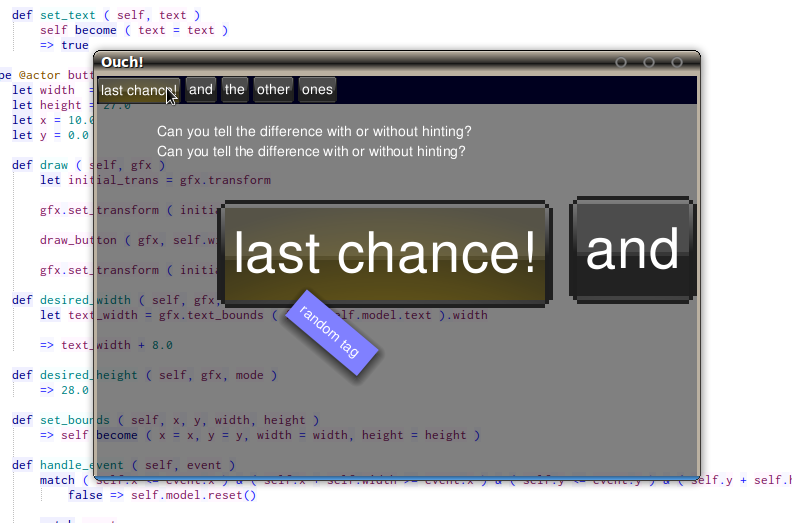I've been playing more with my mostly functional modelling and simulation language (kin), here are some ideas which I want to try and profile to see if they offer gains:
Carrying type and data as a tuple:
Some implementation of Scheme and JavaScript use a single void* size datum for each object, and for integers set the lowest bit and encode the value in the rest, and for other objects the lowest bits are zero due to alignment, and the whole is a pointer to object. That doesn't work very well for doubles, and requires that the type is stored in the object's header. Java, C#, and C++ (for object with a vtable) have type information in the object header, which costs in large arrays. I've been thinking about passing the type and the data around separately, which means you can have more tightly packed arrays for non-vtable types.
One-bit markers for escape detection:
Based on
One-bit Reference Counting, a marker in the type field to distinguish 'shared' objects you can take a reference to, and 'non shared' which you must not.
Write-once arrays:
As an extension to 'one bit reference counting' style; you maintain a high water mark instead of always copying, for use in structures such as VLists so you don't copy on passing automatically, and it allows you to mutate an array if it can be proven that all accesses happen before writes in matrix multiplications:
ax[i] <- ax[i] + row[i] * col[i]
Block order arrays for cache sensitive iteration and super compiled functors:
In a simulation, it's not uncommon to have a reduction on some function of a few attributes of an entity:
let total_force = reduce(array_of_entities, lambda(e:entity, ax) => f.mass * f.acceleration + ax, 0)
If this is over a homomorphic array, and mass and acceleration are simple double values, this would in C translate to picking 8 bytes here and there from the memory for the array. If instead each field is kept either in 'column order', or in what I'll call block order - so the fields for (cacheline size in bytes) objects are held contiguously. This should both reduce cache misses, and allow the use of SIMD instructions to process the data. The obvious disadvantage is that an object in an array is no longer the same layout as a single object on the heap, and to exploit it you need either a super-compiler or a trace-based JIT.
Effective model for scopes based on lists, symbols and objects:
Trying to build an interpreter in Java, which makes it tempting to use maps for everything, I found that the properties of an object and the properties of a lexical scope are much the same, (the duality of closures and objects is well known) so will try and define the binding model for values in kin using symbols, integers and lists only.
Using CAS for thread safe homogeneous VLists
Similar to the vector implementation in
Lock-free Dynamically Resizable Arrays.
Options for compiling Verilog to shader language
Having had an interview last week as a systems modelling engineer with a company who were using C as the modelling
language for timing simulations in embedded memory controllers, which is a bit like going for a job as a car mechanic and discovering that you're being quizzed on your wood-working skills, I was thinking about compiling an appropriate modelling language to something which executes efficiently. Though their particulary problem - timing conflicts - I would have though as having an analytic solution.
Something after UML
Speaking of Verilog, Verilog came into existance because even standardized schematic diagrams don't carry strong enough semantics and are not amenable to algebraic analysis, and graphical notations don't scale to large systems without hiding information.
Pi-calculus came into existance as Petri nets don't scale to large systems and are not amenable to algebraic analysis.
UML is very much in the standardised schematic mould, lacks formal semantics, and relies on hiding information to scale.
Often the hidden information in UML is very important - what appears to be a good design is not a good design if its simplicity is achieved by hiding most of the attributes and operations of a class, as often happens when a class gets multiple unrelated responsibilities. The notation allow you to hide details which should indicate that the design should be factored into smaller units, and in fact encourage such behaviour as a mechanism to scale up to showing many classes. For example, in
Altova UModel:
You can customize the display of classes in your diagram to show or hide individual class properties and operations. ... This feature lets you simplify the diagram to focus on the properties and operations relevant to the task at hand.
If the class has features which are not relevant, then refactor it. Don't hide it so it doesn't make the documentation more complicated. The classes for well-factored systems have nothing to hide, but require more relations between the classes, which UML tools don't handle well (last time I checked none provided basic auto-routing or anything like good layout engines) and look more complicated, even though they are more simple - in the same way a dry stone wall is simpler than a minimalist plastered white apartment, but is visually more complex.
So what might come after UML then? What would not mitigate against refactoring, but allow a visual overview? What notation might give good analytic properties for software, rather than being a system schematic with loose semantics?
I don't know yet.
Labels: kin, languages, programming, uml


